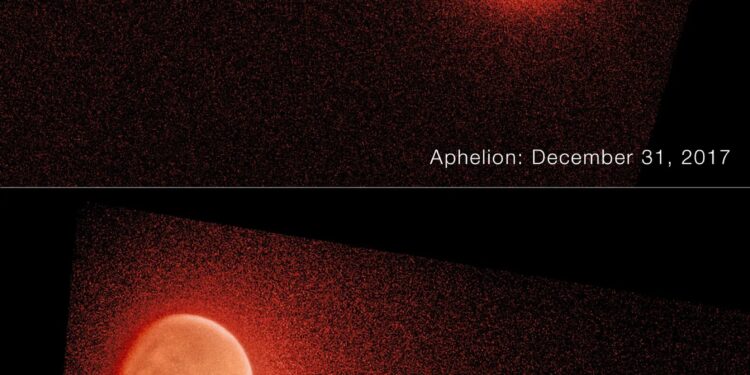Here are Hubble far-ultraviolet images of Mars near its farthest point from the Sun, called aphelion, on December 31, 2017 (top), and near its closest point to the Sun, called perihelion, on December 19, 2016 (bottom). The atmosphere is clearly brighter and more expansive when Mars is close to the Sun. Sunlight reflected off Mars at these wavelengths shows scattering by atmospheric molecules and haze, while polar ice caps and some surface features are also visible. Hubble and MAVEN have shown that Martian atmospheric conditions change very rapidly. When Mars is close to the Sun, water molecules rise very quickly into the atmosphere, break apart, and release atoms at high altitudes. Credit: NASA, ESA, STScI, John T. Clarke (Boston University); Processing: Joseph DePasquale (STScI)
Mars was once a very wet planet, as evidenced by the geological features of its surface. Scientists know that over the past 3 billion years, at least some of the water has seeped deep underground, but what happened to the rest? Now, NASA’s Hubble Space Telescope and the Mars Atmosphere and Volatile Evolution (MAVEN) missions are helping to solve this mystery.
“Water can only go in two directions: It can freeze into the ground, or the water molecule can break into atoms, and those atoms can escape from the surface of the atmosphere into space,” said John Clarke, lead author of the study at Boston University’s Center for Space Physics in Massachusetts. “To understand how much water is there and what happened to it, we need to understand how the atoms escape into space.”
Clarke and his team combined data from Hubble and MAVEN to measure the number and current rate of escape of hydrogen atoms into space. This information allowed them to extrapolate the escape rate back in time to understand the history of water on the Red Planet.
Their study is published in the journal Scientific progress.
Escaping hydrogen and heavy hydrogen
Water molecules in the Martian atmosphere are broken down by sunlight into hydrogen and oxygen atoms. Specifically, the team measured hydrogen and deuterium, a hydrogen atom with a neutron in its nucleus. This neutron gives deuterium twice the mass of hydrogen. Because it has a higher mass, deuterium escapes into space much more slowly than regular hydrogen.
Over time, as hydrogen lost more than deuterium, the ratio of deuterium to hydrogen increased in the atmosphere. Measuring this ratio today gives scientists an idea of how much water was present on Mars during the warm, wet period. By studying how these atoms are escaping now, they can understand the processes that determined escape rates over the past four billion years and extrapolate back in time.
Although most of the data for the study came from the MAVEN spacecraft, it is not sensitive enough to observe deuterium emission at all times of the Martian year. Unlike Earth, Mars wobbles away from the Sun in its elliptical orbit during the long Martian winter, and deuterium emissions become faint. Clarke and his team needed the Hubble data to “fill in the gaps” and complete an annual cycle of three Martian years (each representing 687 Earth days). Hubble also provided additional data going back to 1991, before MAVEN arrived on Mars in 2014.
Combining data from these missions provided the first holistic view of hydrogen atoms escaping from Mars into space.
A dynamic and turbulent Martian atmosphere
“In recent years, scientists have discovered that Mars has a much more dynamic annual cycle than people thought 10 or 15 years ago,” Clarke says. “The atmosphere as a whole is very turbulent, warming and cooling over short periods of time, sometimes hours. The atmosphere expands and contracts when the brightness of the sun on Mars varies by 40% over the course of a Martian year.”
The team found that the escape rates of hydrogen and deuterium change rapidly as Mars gets closer to the Sun. In the conventional picture scientists had until then, it was thought that these atoms slowly diffused upward through the atmosphere to a height where they could escape.
But this picture no longer really reflects reality, because scientists now know that atmospheric conditions change very quickly. When Mars is close to the Sun, water molecules, which are the source of hydrogen and deuterium, rise very quickly in the atmosphere, releasing atoms at high altitudes.
The second discovery is that the changes in hydrogen and deuterium are so fast that atomic escape requires extra energy to explain them. At the temperature of the upper atmosphere, only a small fraction of atoms have enough speed to escape Mars’ gravity. Faster (superthermal) atoms are produced when something gives the atom an extra boost of energy. Such events include collisions of protons from the solar wind entering the atmosphere, or sunlight triggering chemical reactions in the upper atmosphere.
Serve as a proxy
Studying the history of water on Mars is fundamental not only to understanding the planets in our solar system, but also to understanding the evolution of Earth-sized planets around other stars. Astronomers are discovering more and more of these planets, but they are difficult to study in detail.
Mars, Earth, and Venus are all in or near our solar system’s habitable zone, the region around a star where liquid water could accumulate on a rocky planet. Yet these three planets have dramatically different current conditions. Along with its sister planets, Mars can help scientists understand the nature of distant worlds in our galaxy.
More information:
John T. Clarke et al., Martian Atmospheric Hydrogen and Deuterium: Seasonal Changes and the Escape to Space Paradigm, Scientific progress (2024). DOI: 10.1126/sciadv.adm7499
Quote:NASA’s Hubble and MAVEN help solve the mystery of water leaking from Mars (2024, September 5) retrieved September 6, 2024 from
This document is subject to copyright. Apart from any fair dealing for the purpose of private study or research, no part may be reproduced without written permission. The content is provided for informational purposes only.



